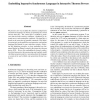18 search results - page 3 / 4 » The size-change principle for program termination |
GECCO
2004
Springer
13 years 11 months ago
2004
Springer
Genetic Programming uses trees to represent chromosomes. The user defines the representation space by defining the set of functions and terminals to label the nodes in the trees....
SCP
2011
13 years 22 days ago
2011
A definitional extension LNGMIt of the Calculus of Inductive Constructions (CIC), that underlies the proof assistant Coq, is presented that allows also to program with nested dat...
ACSD
2001
IEEE
13 years 9 months ago
2001
IEEE
We present a new way to define the semantics of imperative synchronous languages by means of separating the control and the data flow. The control flow is defined by predicates th...
APLAS
2007
ACM
13 years 9 months ago
2007
ACM
Abstract. We introduce the concept of guarded saturated sets, saturated sets of strongly normalizing terms closed under folding of corecursive functions. Using this tool, we can mo...
COMPSAC
2000
IEEE
13 years 10 months ago
2000
IEEE
Genetic programming tackles the issue of how to automatically create a working computer program for a given problem from some initial problem statement. The goal is accomplished i...


